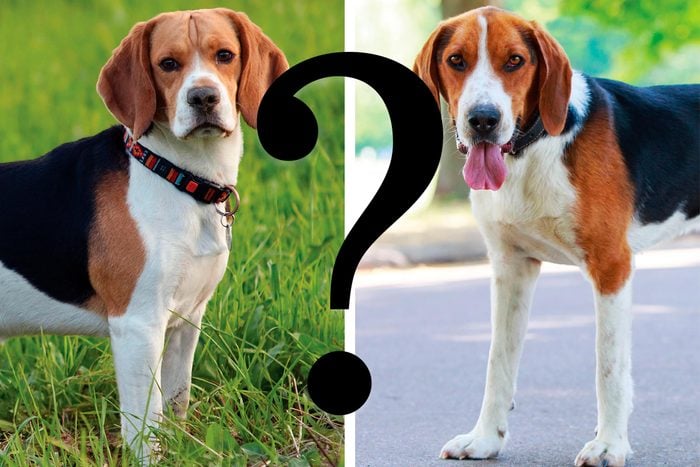
Can you tell the difference?
Is that sweet dog on the sidewalk, a miniature schnauzer or Scottish terrier? They both have the trademark features of each breed—a distinguished beard and hairy arched eyebrows. And what about that dainty, albeit cocky Pomeranian holding court at the dog park. Wait, it has a fluffy body and foxy head like the Keeshond playing in the grass. Read on for our fun guessing game and don’t miss the 50 cutest dog breeds as puppies.
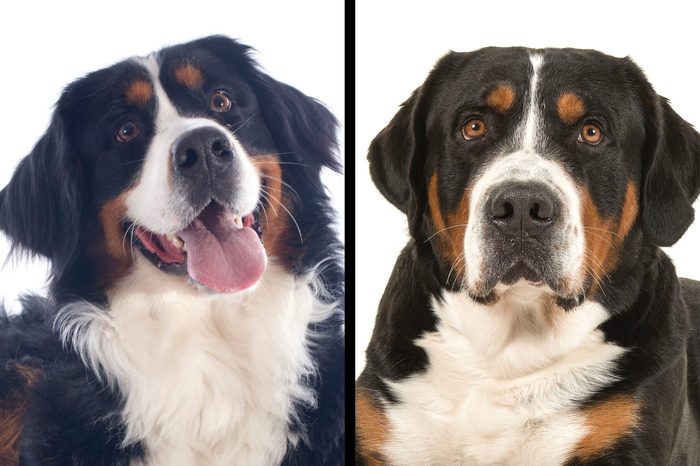
Bernese mountain dog vs. Greater Swiss Mountain Dog
These two hunksters have a lot in common: To start with they both have a tri-color coat with a white blaze on the face and rusty colored dots above the eyes. They both hail from Switzerland and are loyal and lovable. But can you believe the Greater Swiss actually weighs more than the Bernese, which already tops the scales at 100+ pounds? The Greater Swiss is brawny and muscular. Males can weigh as much as 140 pounds, while the Bernese is more fluffy-than-stuffy and maxes out at 115 pounds. Another point to consider is that the Bernese sheds considerable more. If you don’t want fur flying, check out these dogs that don’t shed (that) much.
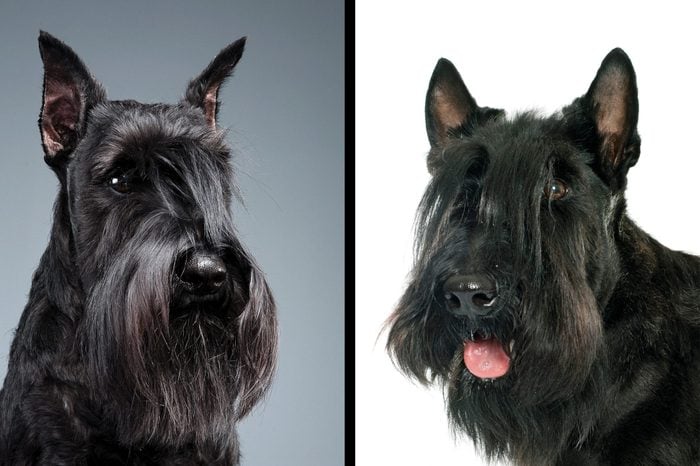
Schnauzer vs. Scottish terrier
Check out the distinguished ‘staches and hairy eyebrows on these two! Both dogs have that aristocratic look going for them, but the Scottish Terrier has a dignified, human-like character who is “all business,” except when its hunting instincts kick in. Scotties have a compact body and are shorter and heavier than the taller and leaner Schnauzer. Meanwhile, the Schnauzer tends to be the life of the party and is alert, active, a trusted family watchdog. Most dogs aren’t happy when they’re away from their people, but in general, this is how long it’s OK to leave your dog home alone.
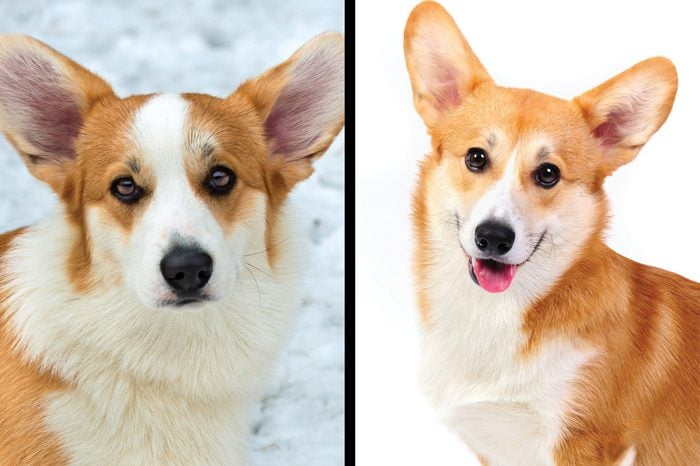
Cardigan Welsh corgi vs. Pembroke Welsh corgi
We’ll give it to you: These corgis are almost identical—but they are actually two different breeds. Look closely, and you’ll see the cardigan corgi has a tail that sits low on the body, but the Pembroke has a docked tail. The cardigan has been along much longer than the more popular Pembroke breed. Both are undeniably cute, loyal, and smart, yet the Pembroke is more popular, likely due to Queen Elizabeth II’s love for Pembroke corgis over the years.
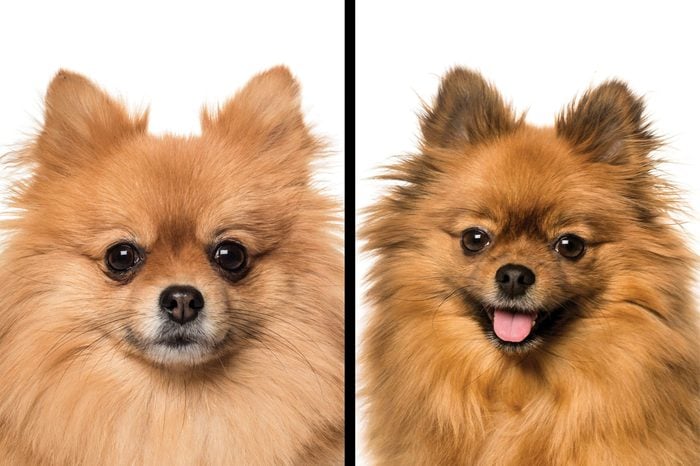
Pomeranian vs. Keeshond
Are these sweet little foxy faces twinsies? Nope. The Pomeranian and Keeshond are both from the Spitz family, a type of breed built for cold weather with thick coats, and curled-up bushy they use to keep their nose warm when they sleep. Pom-poms, as fans call them, are spunky, independent, and bold. They love their family, are aloof with strangers, and a bit cocky at the dog park. Keeshonds, are less independent—more touchy-feely and get along with other pets. Maybe that’s why they have the distinct honor of being the National Dog of Holland. One thing is sure they’re in the same bunch of pups that look a heckuva lot like the teddy bears.
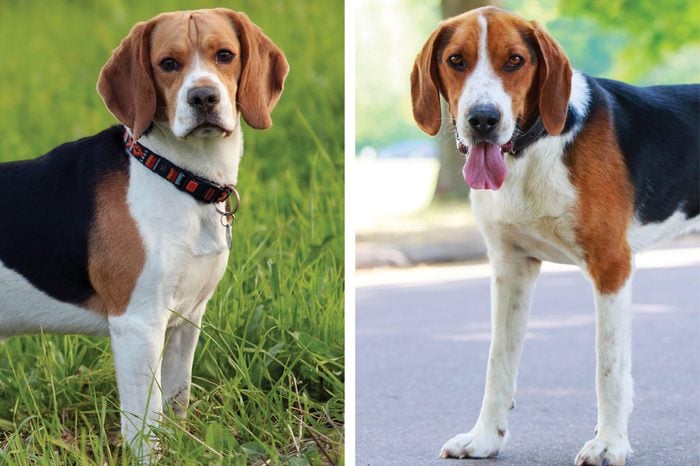
Beagle vs. American foxhound
These hunting breeds with a timeless youthful puppy dog face could impersonate each other and no-one would be the wiser. They’re both compelled to track an intriguing scent and bray loudly when they find it. Independent, yet sweet-tempered with people and easy-going with their own pack, they make great family pets. The main difference is in size: Beagles are noticeably shorter and lighter at 15 inches, 35 pounds. The American foxhound stands at 25 inches and weighs n around 65 pounds. Here’s why all dogs bray—and howl.
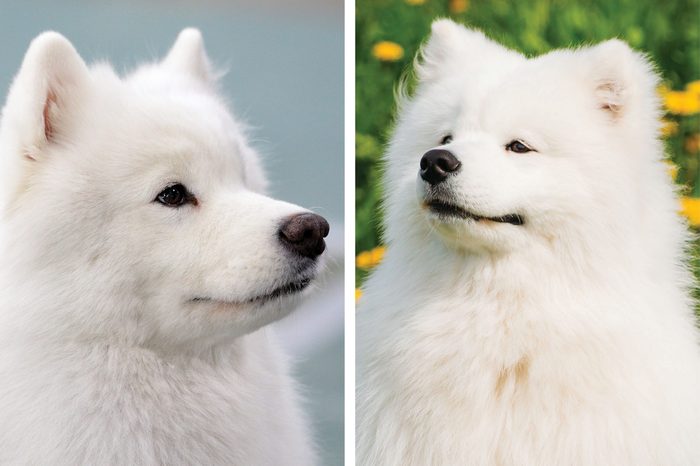
Samoyed vs. American Eskimo dog
Most famous for their fluffy white coat, bright, expressive eyes, and adorable “smiling” face, the American Eskimo and Samoyed look like they came from the same litter. Eskies come in three delightful sizes, ranging from a petite 9 inches to a larger19 inches. Samoyeds are larger at around 24 inches tall and 65 pounds in weight. The Eskies shine at herding tasks with a quick and nimble speed, while the brawny Samoyed loves to pull sleds. Keep these 28 safety tips in mind when you take your dog outside to play.
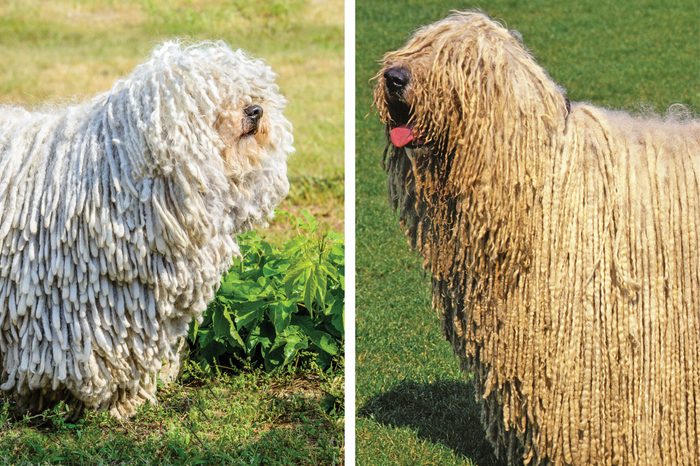
Puli vs. Komondor
You might call these dogs adorable cords, shaggy sweeties or mushy mops. The coats of both the Puli (pronounced Poo-lee) and Komondor require lots of attention, but Puli parents will have less of it to do as it is a little nugget of 17 inches in height and 35 pounds compared to the Komondor who stands about 27 inches and is 100 pounds or more. Pulis earned the reputation for being the “acrobat of the dog world” for being agile and nimble on their feet. Komondors are quick on their feet too, but generally prefer to sit on the sidelines protecting their family. Finally—the reasons behind your dog’s weird behavior are explained.
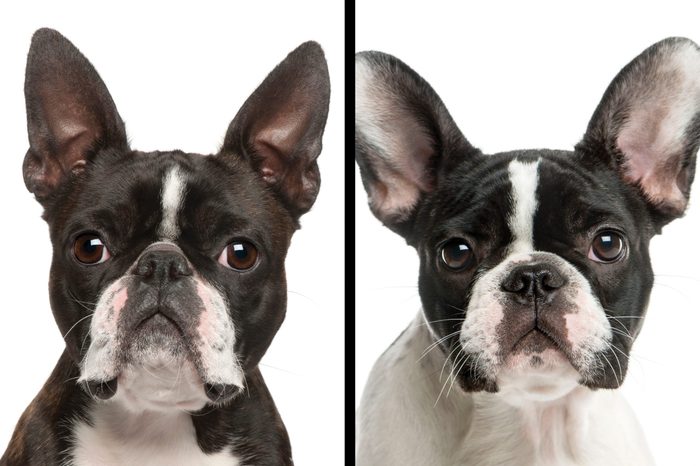
Boston terrier vs. French bulldog
The best-dressed award might go to the tuxedo-wearing swanky Boston terrier, but the French bulldog isn’t without its own bow-wow factor with its irresistible gremlin-like face. Besides their similar size and markings, they even harder to tell apart because they both make the most adorable little snorts, grunts, and snoring when they sleep. By the way, Frenchies aren’t from France; lace workers from England went to work in France and took their Frenchies. Parisian women swooned over them and named them bouledogue francais. Bosties, however, originated in their namesake city of Boston. Choose either one, and you’ll have one of the 14 best short-haired dogs for families.
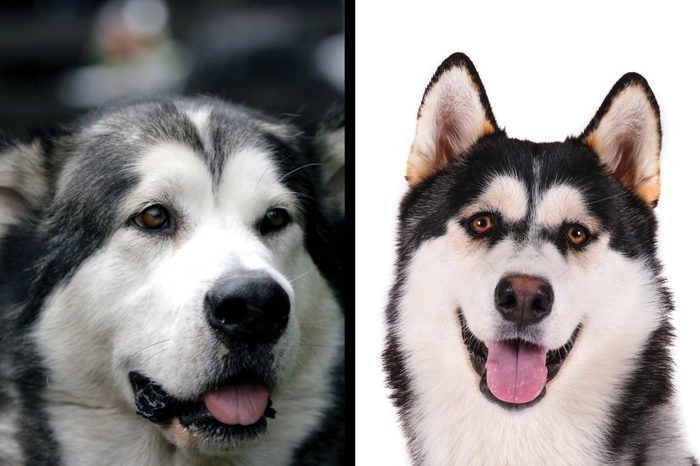
Alaskan malamute vs. Siberian husky
Don’t you just want to put your cheeks against these big furry heads for a muzzle snuggle? Both are built for cold weather. The heftier Alaskan malamute resided with the Mahlemut people on Alaska’s northwest coast. In World War II, malamutes used their strength to haul supplies and act as search and rescue dogs. Equally impressive, the Siberian husky developed by the nomadic Chukchi people of northeast Asia is one of the most ancient breeds. In 1925, a Siberian husky named Balto led his sled dog team and raced 340 miles in six days to deliver serum to diphtheria-stricken Nome. That’s a lot of exercise! Here’s how much exercise your pup really needs each day.
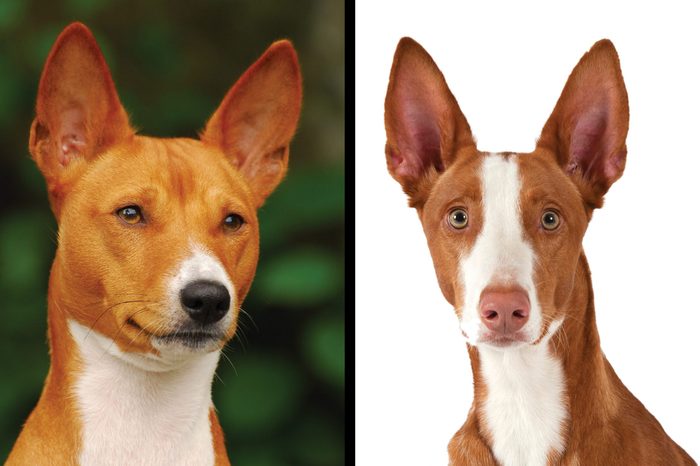
Basenji vs. Ibizan hound
They may share a physical resemblance, but the Basenji and Ibiza hound are very different in character. Basenji, aren’t like most dogs in that they possess catlike mannerisms, being fastidious groomers, inquisitive, independent, and stubborn. They’re ideal for people who love cats and dogs! The Ibizan hound’s early days were on the rocky coast of the Balearic Islands, where it employed its world-class sprinter and leaper skills to hunt rabbits for their own food and for the islanders. It’s an outgoing, well-mannered, and family-orientated member of the family. These are more dog breeds that don’t bark too much.
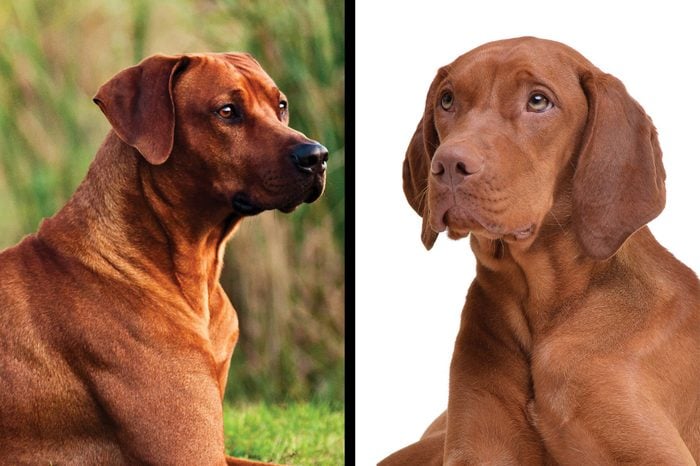
Vizsla vs. Rhodesian ridgeback
The similarities are striking on the Vizsla and Rhodesian ridgeback: Both breeds are strong muscular hounds with gorgeous red wheaten coats and velvety soft ears. There’s one distinguishing feature on the Rhodesian ridgeback that sets these two look-alikes apart. (Hint: it’s part of its name). Notice the ridge of hair running the opposite direction along the back of the Rhodesian ridgeback. Both breeds were bred for hunters: The Rhodesian dubbed the lion dog hails from Africa and the Vizsla is a scent chaser and pointer from Hungary. These days the Vizsla uses his nose for the TSA and for search and rescue missions. All dogs, regardless of breed, need to learn puppy manners first. Here’s what you should look for in a dog obedience school before enrolling your pup.

Azawakh vs. greyhound
These pups look like they good use a few more hearty meals. Even though you can see their ribs, the Azawakh and greyhound are naturally lean with thin coats that show off their bones and musculature. Both are sighthounds, meaning they chase game by sight instead of smell; they’re wicked fast and excel at lure chasing. And while they might not look the touchy-feely type, they are as both breeds are sweet and affectionate. The greyhound has been on the American Kennel Club registry since 1885. The Azawakh is a newcomer and recognized by the AKC in 2019.
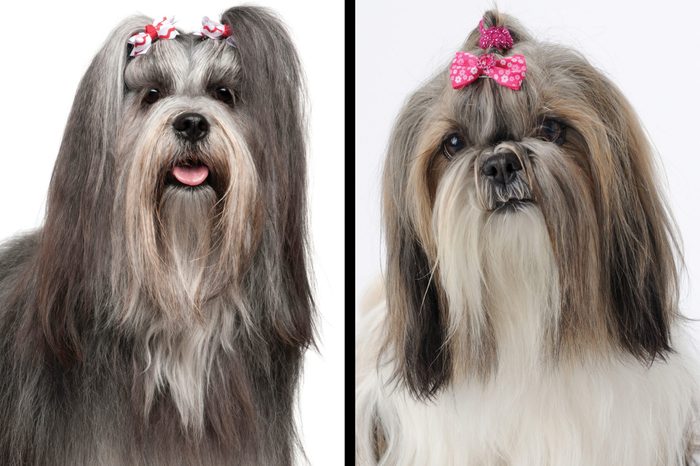
Lhasa Apso vs. Shih Tzu
“When your dog is having a better hair day than you,” might be the caption of the Lhasa Apso and Shih Tzu. Dainty and sweet, these adorable lapdogs are originally from Tibet. The Lhasa Apso origins go way back to 800 A.D. As sacred and pampered pooches, Tibetan Buddhists believe in reincarnation— specifically, that the Lhasa Apso is the stage that comes right before a human. The Shih Tzu is thought to be a mix of the Lhaso Apso and the Pekingese. Whether your dog wears cute bows or gets a trim on the regular, all pet groomers wish you knew these secrets.
